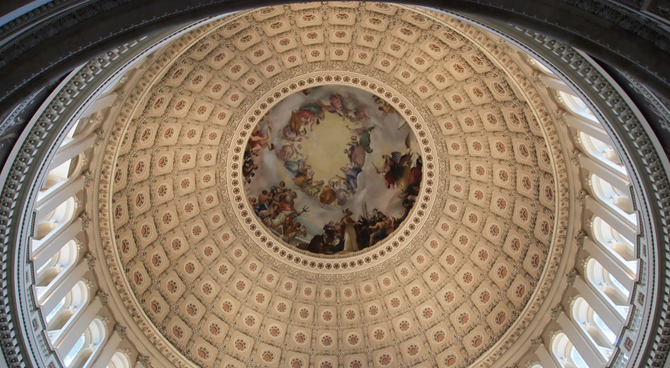Banks’ excess reserves limited the money supply after 2008, but looser rules today might give way.
By Phil Gramm and Mike Solon
May 28, 2020 7:08 pm ET
Is there any limit to the power Congress is willing to give to the Federal Reserve? Since 2008 lawmakers have granted the Fed the ability to pay interest on excess reserves, which allows it to buy vast quantities of government and private securities with money borrowed from the banking system. The Dodd-Frank Act of 2010 made the Fed the nation’s dominant financial regulator, free of the checks and balances other agencies face from annual congressional funding, bipartisan commissions and congressional reauthorization.
Now in response to the pandemic shutdown, Congress has at least temporarily made the Fed the nation’s dominant lender to private businesses by guaranteeing the Fed’s loans at subsidized interest rates and substituting the Cares Act’s political mandates and Fed discretion for market credit allocation. At what point does this process endanger not only economic efficiency but freedom itself?
When the Fed purchased $3.7 trillion of government and private debt in 2008-14 and, defying conventional economic wisdom, caused no inflation, a new illusion took hold of the political left: Modern Monetary Theory, which holds that the Fed can provide virtually unlimited funding with little downside.
The massive amount of debt purchased by the Fed didn’t increase the money supply and create inflationary pressures, because the Fed implemented a new policy the public and many knowledgeable commentators and economists still don’t fully understand. For the first time, Congress empowered the Fed to pay interest on excess reserves, converting those reserves into an investment asset for banks and making it possible for the Fed to borrow massive amounts of money from the banks.
The effect of the Fed purchases was the same as it would have been had banks or private investors bought the securities directly instead of the banks lending the Fed money to buy the securities. When these purchases occurred, the money supply grew at the modest annual rate of less than 7% and bank lending was similarly muted. No monetary easing occurred and no inflationary pressures were generated. Banks now hold more in interest-bearing excess reserves than they have in outstanding demand deposits or industrial and commercial loans, and the Fed holds unprecedented levels of public and private debt.
At the same time the Fed began using interest payments to give banks an incentive to hold excess reserves, Dodd-Frank allowed it to mandate higher levels of excess reserves through the new liquidity and capital requirements imposed by its stress tests, as well as living wills, liquidity coverage ratios, comprehensive capital annual reviews and many other requirements. For a decade, the Fed was able to induce and require banks to hold massive excess reserves and prevent the explosive growth of the money supply that would otherwise have resulted from its debt purchases.
Now with the economy in a deep contraction due to the coronavirus shutdown, the Fed has pumped another $2.9 trillion of liquidity into the system since March and, based on legislated Treasury guarantees, the central bank has been empowered to lend $4 trillion directly to the private sector at concessionary interest rates. The Fed has also reduced the interest rate it pays on excess reserves and partly waved many capital requirements imposed under Dodd-Frank. In contrast with Fed policy during the Obama era, banks now have a strong incentive to lend out their massive excess reserves.
With the Fed lending at concessionary rates amid collapsing private investment, the banking system is unlikely to find much demand for private credit during the coronavirus lockdown. But during the recovery, with capital-depleted companies desperate for credit, banks will have both the capacity and the incentive to expand loans, ballooning the money supply and creating inflationary pressures.
During the Obama era, the Fed borrowed the money from banks to finance the purchase of public and private debt, and no monetary expansion occurred. Modern monetary theory was therefore never tested. This time nothing is offsetting the impact of the Fed’s liquidity injection or the monetary expansion that will occur as the Fed lends $4 trillion to private business. In the past two months, the money supply has risen at an annualized rate of 102% and the excess reserves of the banking system have doubled.
The Fed certainly has tools to stop private lending and the explosion of the money supply. It can sell securities, raise the interest rate on excess reserves, raise reserve requirements, and reimpose all the Dodd-Frank mandates. The question is whether the Fed can undertake these measures at the same time the Treasury is trying to sell $3.7 trillion of government bonds to fund a federal deficit of 18% of gross domestic product without derailing the recovery. This problem will be compounded by the fact that China, Japan, the U.K. and the European Union will also be borrowing to finance their massive stimulus programs and trying to reverse their monetary expansions.
Worst of all, public lending to private business could become permanent. If the Fed can’t end its $4 trillion lending at subsidized rates and reverse its monetary expansion without leaving the banking system and the economy crippled, will Congress extend the Fed’s business-lending role beyond the scheduled Dec. 31 end date? We are perilously close to finding out whether the Fed can create a virtually unlimited supply of credit with no adverse effects, and whether credit can long be allocated politically rather than by market forces without threatening America’s prosperity and freedom.
Mr. Gramm is a former chairman of the Senate Banking Committee. Mr. Solon is a partner of US Policy Metrics.




